Stress Management with Yoga: 5 Stunning Yoga Poses
Unlock serenity with stress management through yoga. Embrace holistic practices for calmness amid chaos. Explore yoga’s power for inner peace.
Stress management with yoga
In the hustle of modern life, where stress relentlessly knocks on our doors, finding solace becomes an invaluable pursuit. Among this chaos, yoga emerges as a sanctuary, offering not just physical tranquility but also mental repose. Stress management with yoga isn’t merely about twisting into poses; it’s a profound journey that intertwines breath, movement, and mindfulness to alleviate the burdens we carry.
Let’s embark on this transformative exploration, delving into specific yoga exercises meticulously designed to unravel tension, usher in serenity, and empower you on your quest for inner peace.
Child’s Pose Yoga
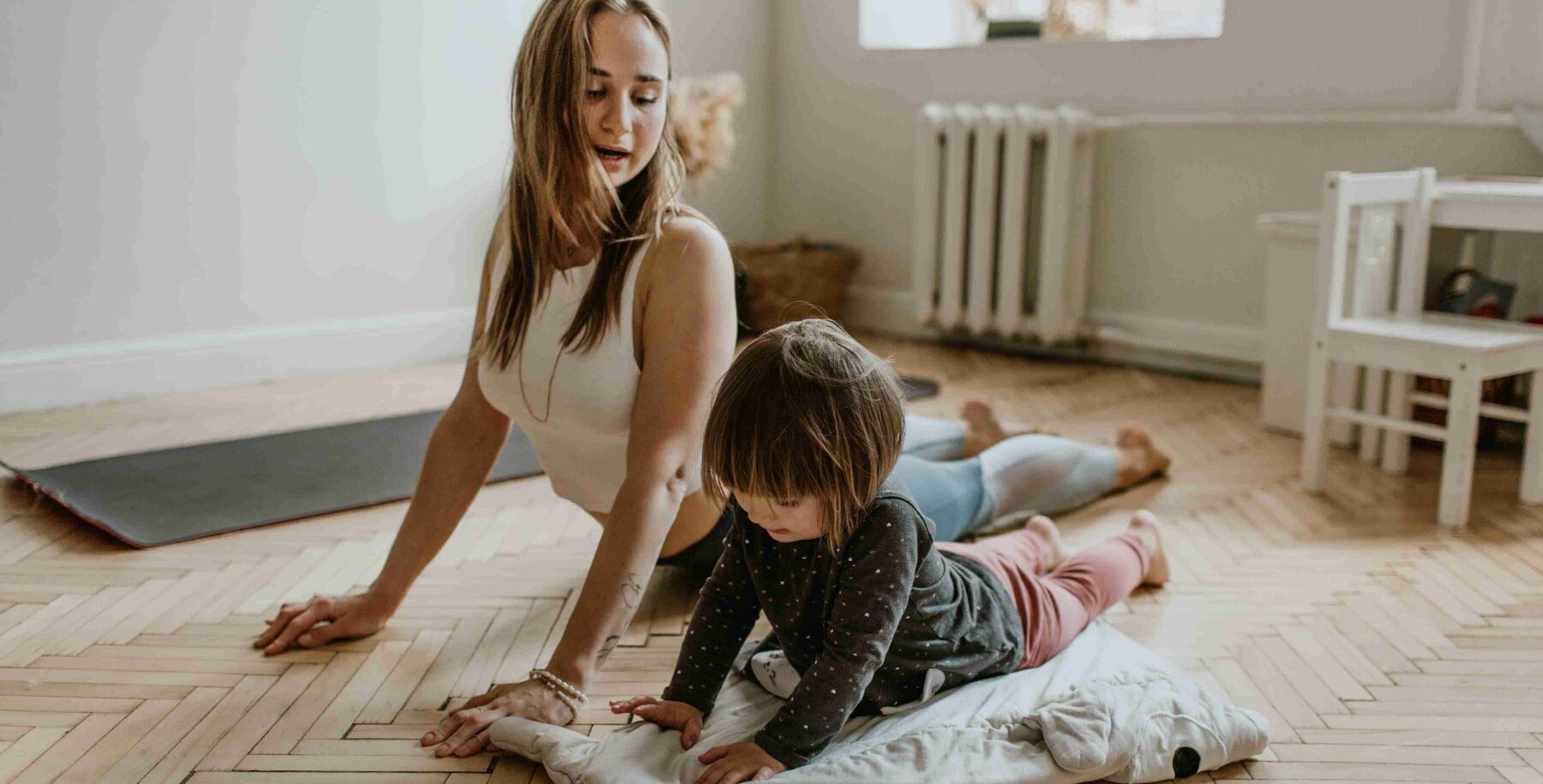
The Child’s Pose, known as Balasana in Sanskrit, stands as a cornerstone in stress management with yoga. This grounding posture gently stretches the lower back, hips, and thighs, providing a soothing release from the burdens of daily life.
By fostering a deep sense of relaxation and surrender, this pose becomes a pivotal tool in the quest for mental tranquility. It involves kneeling on the floor, sitting back on your heels, and extending the arms forward, nurturing a gentle stretch through the spine and shoulders.
Steps:
- Start in a kneeling position, sitting back on your heels, toes touching, and knees apart.
- Gradually lower your torso forward, extending your hands out in front of you on the mat.
- Allow your forehead to rest on the ground or a yoga block, fully extending your arms.
- Focus on deep, mindful breathing, allowing each breath to expand your rib cage.
- Consciously relax your shoulders and release any built-up tension in your body.
- Hold this calming posture for 5-10 breaths, embracing the gentle stretch along your spine and hips.
What Makes This Exercise Special for Stress Management:
Child’s Pose in the realm of stress management with yoga acts as a haven, offering a comforting stretch that aids in releasing tension in the back, shoulders, and hips. Its nurturing nature encourages a sense of surrender, inviting a moment of introspection and calm amidst the chaos of daily life.
Cat-Cow Pose Yoga

The Cat-Cow Pose, often referred to as Chakravakasana, embodies an integral practice in stress management with yoga. This dynamic sequence involves a fluid movement between arching and rounding the spine, syncing breath with motion to alleviate stress.
Starting on all fours, the Cat-Cow sequence invites a gentle release of tension in the spine and abdomen. Transitioning from a rounded spine to an arched back, it encourages a rhythmic flow of breath, fostering a sense of grounding and tranquility.
Steps:
- Begin in a tabletop position, aligning wrists under shoulders and knees under hips.
- As you inhale, arch your back, drop your belly towards the mat, and lift your gaze (Cow Pose).
- Exhale slowly, rounding your spine upwards, tucking your chin towards your chest (Cat Pose).
- Repeat this sequence, synchronizing breath with movement, for a few cycles.
- Focus on the fluidity of the motion, letting each breath guide your body’s gentle flow.
- Continue this rhythmic sequence for 5-10 breath cycles, feeling the calming effect on your mind and body.
What Makes This Exercise Special for Stress Management:
Cat-Cow Pose, within the realm of stress management with yoga, serves as a powerful tool for spinal flexibility and stress alleviation. Its rhythmic, synchronized movement with breath fosters a profound mind-body connection, aiding in releasing tension and promoting a sense of calm and balance amidst daily stressors.
Downward-Facing Dog Pose Yoga
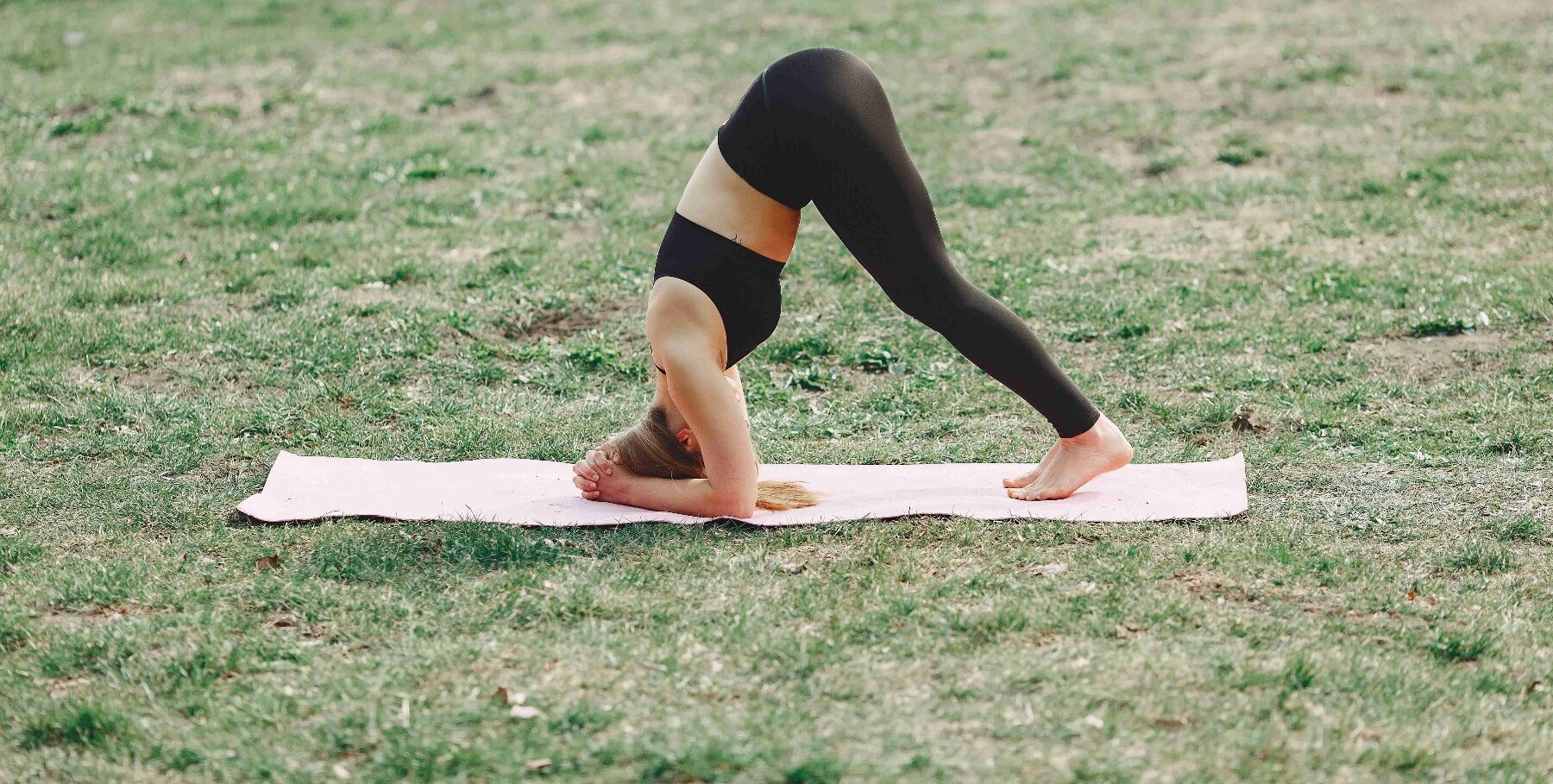
The Downward-Facing Dog Pose, or Adho Mukha Svanasana, epitomizes an essential posture in stress management with yoga. This iconic pose combines a full-body stretch with a gentle inversion, creating an opportunity to release tension while rejuvenating the mind.
Beginning in a plank position, this pose involves lifting the hips upward, forming an inverted V-shape, and grounding the heels towards the floor, offering a lengthening sensation through the spine and hamstrings.
Steps:
- Start in a plank position, aligning your wrists under your shoulders and spreading your fingers wide.
- Lift your hips upward and backward, forming an inverted V-shape with your body.
- Press firmly into your palms and heels while grounding your heels towards the mat.
- Keep a slight bend in your knees to maintain the length of your spine.
- Engage your core and draw your shoulder blades towards your tailbone.
- Hold this pose for 5-10 breaths, focusing on elongating the spine and releasing tension.
What Makes This Exercise Special for Stress Management:
Downward-Facing Dog Pose within stress management with yoga stands as a rejuvenating posture that stretches and invigorates the entire body. Its inverted nature facilitates a calming effect on the mind, encouraging deep breathing and aiding in relieving stress and fatigue from the day’s demands.
Legs-Up-The-Wall Pose Yoga
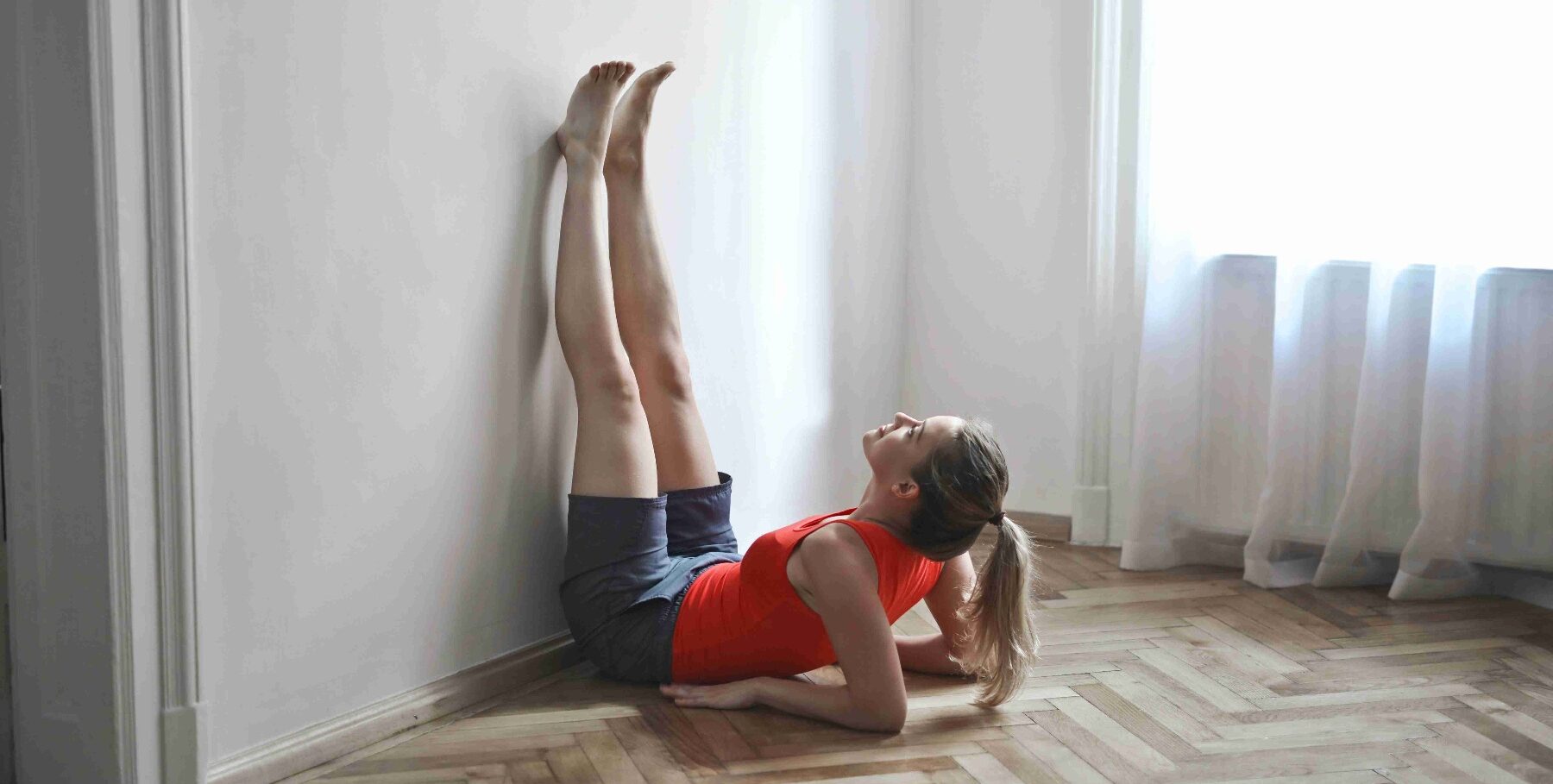
The Legs-Up-The-Wall Pose, known as Viparita Karani, embodies an essential relaxation posture in stress management with yoga. This gentle inversion offers a moment of respite from the pressures of everyday life by promoting relaxation and rejuvenation. It involves lying on your back, placing your legs vertically up against a wall, creating a mild inversion that encourages blood circulation and a soothing release of tension in the legs and lower back.
Steps:
- Sit sideways against a wall, with one side of your body touching the wall.
- Gently lower your back onto the mat and swing your legs up against the wall.
- Adjust your position until your legs are comfortably resting against the wall.
- Keep your arms by your sides, palms facing up, or place them on your abdomen for added relaxation.
- Close your eyes and focus on slow, deep breaths, allowing your body to relax fully.
- Stay in this restorative pose for 5-15 minutes, embracing the tranquility it offers.
What Makes This Exercise Special for Stress Management:
Legs-Up-The-Wall Pose in stress management with yoga serves as a therapeutic posture that promotes relaxation and stress relief. This gentle inversion facilitates improved blood circulation, aiding in calming the nervous system and restoring balance, providing a much-needed respite from daily stressors.
Corpse Pose (Savasana)
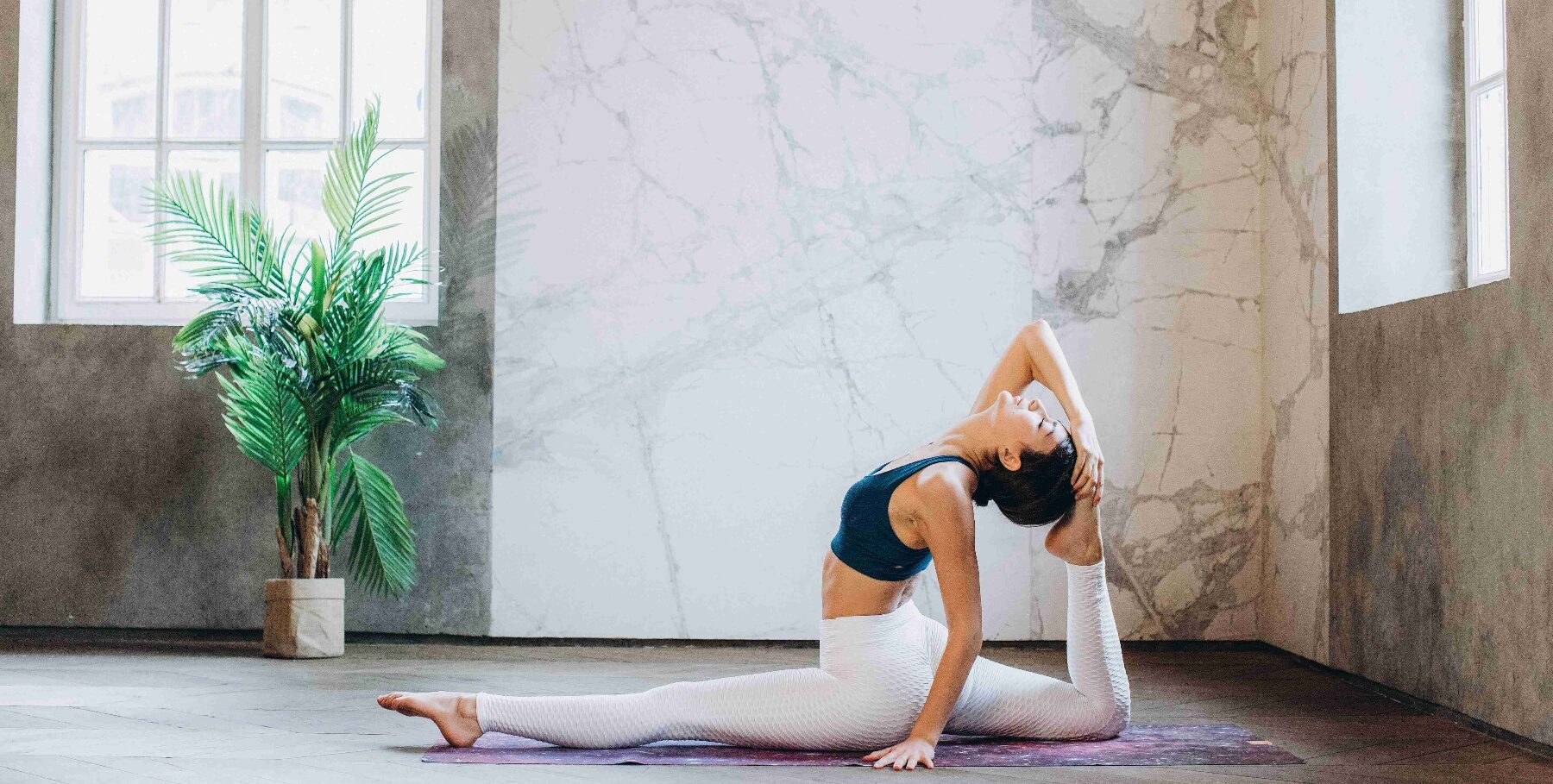
The Corpse Pose, or Savasana, encapsulates the pinnacle of relaxation in stress management with yoga. This pose signifies a moment of total surrender, allowing the body and mind to unwind completely. It involves lying flat on your back, arms relaxed by your sides, and legs slightly apart, inviting a deep state of relaxation and rejuvenation.
Steps:
- Lie down on your back, ensuring your body is comfortable and well-supported by the floor.
- Let your arms rest comfortably by your sides, palms facing up, with a slight space between your legs.
- Close your eyes gently and focus on your natural breath without altering it.
- Start from your toes, consciously relaxing each body part, progressing upwards to your head.
- Release any tension in your muscles, allowing yourself to sink into the mat.
- Stay in this pose for 5-10 minutes, embracing the sense of calm and serenity.
What Makes This Exercise Special for Stress Management:
Corpse Pose, within stress management with yoga, acts as a profound tool for relaxation and refreshment. It offers a space for complete surrender, aiding in the release of physical and mental tension, promoting deep relaxation, and fostering a sense of peace amidst life’s chaos.
Alternate Nostril Breathing (Nadi Shodhana)
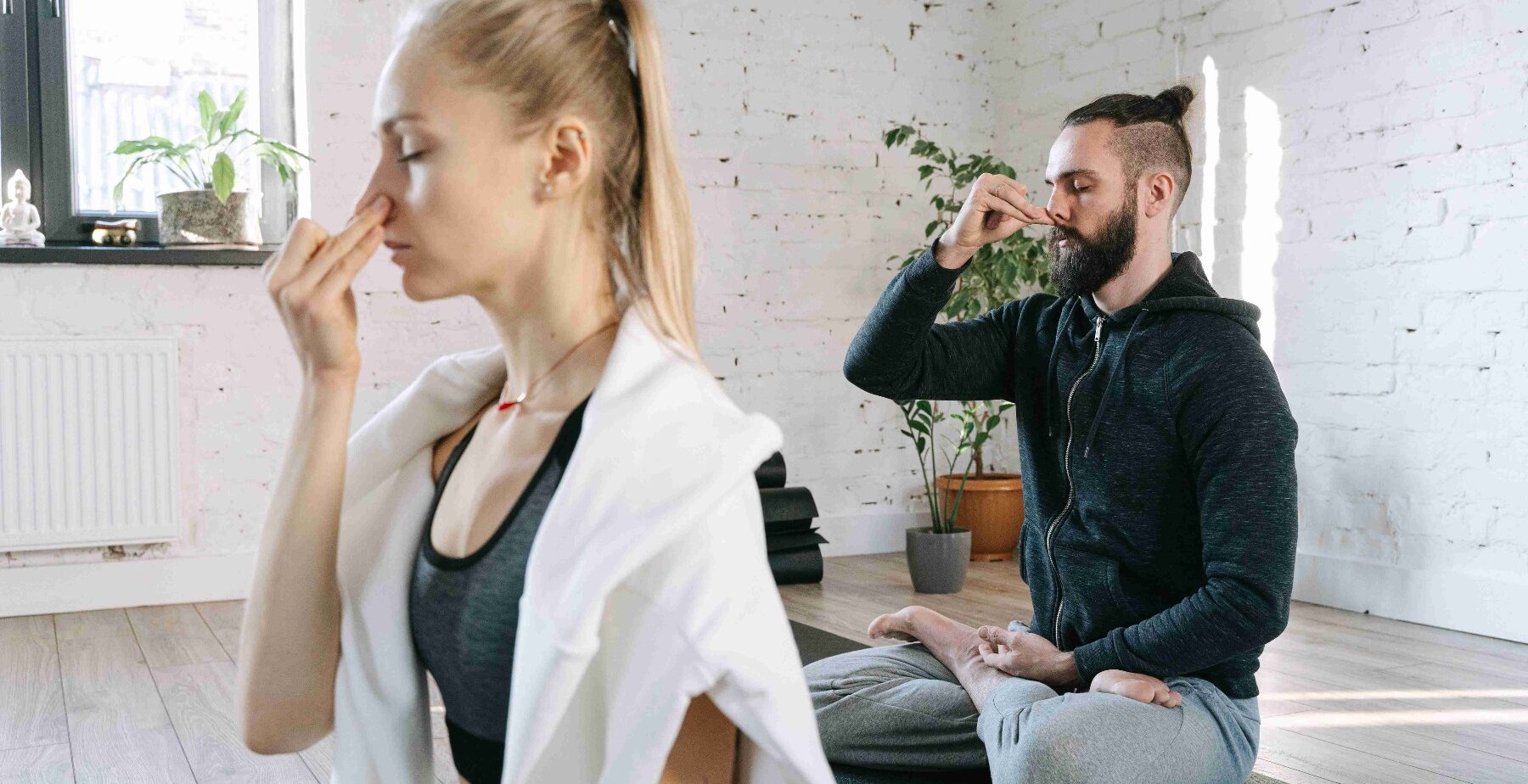
Alternate Nostril Breathing, known as Nadi Shodhana, stands as a vital pranayama (breathing) technique in stress management with yoga. This technique involves consciously breathing through alternate nostrils, facilitating balance and harmony within the body and mind.
By using the thumb and ring finger to alternate closing nostrils, this practice encourages deep, mindful breathing, aiding in stress reduction and mental clarity.
Steps:
- Sit comfortably in a cross-legged position, spine erect but relaxed.
- Place your left hand on your left knee in Gyan Mudra (touching thumb and index finger).
- Use your right hand’s thumb to close your right nostril and inhale deeply through the left nostril.
- Close the left nostril with your ring finger, exhaling slowly through the right nostril.
- Inhale through the right nostril, then close it with your thumb and exhale through the left nostril.
- Continue this rhythmic breathing, alternating nostrils for several cycles, focusing on the breath’s soothing rhythm.
What Makes This Exercise Special for Stress Management:
Alternate Nostril Breathing in stress management with yoga acts as a balancing technique, fostering mental clarity and reducing stress. Its focus on mindful breath regulation aids in calming the mind, balancing emotions, and promoting a sense of inner harmony amidst life’s pressures.
Overview
In the harmonious symphony of breath, movement, and mindfulness, stress management with yoga unveils a profound journey toward serenity. As you weave these practices into your routine, the burdens of daily life dissipate. Stress management with yoga transcends physical postures; it’s a holistic approach to finding peace amid life’s chaos. Embrace these practices, and let the gentle flow of yoga guide you toward tranquility and well-being.
Start your path to inner peace today!



